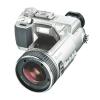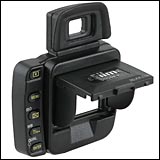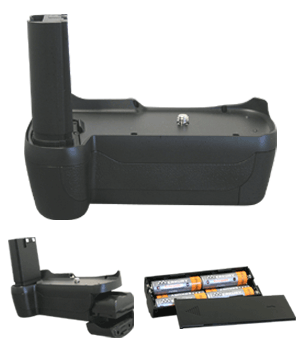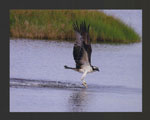February 27, 2006 :: Sony 828/717, Canon Digital Rebel, Nikon D70s, and Nikon D50.

|
This review started with the focus on the Nikon D50.
However, since the announcement of this upcoming
review, and the number of your emails and the
various requests regarding comparisons, and other
related topics, we have greatly expanded the review.
The process took a bit longer. We hope you find the
result useful. First and foremost, we must forewarn
the unsuspecting and prospective buyer: "be ware!"
Be very careful when trying to buy digital
electronic equipment on-line. Be ware of "bait and
switch". There are a large number of what seem to
look and feel like very reputable sellers, that are
impersonators. These will low-ball the price of what
you want to get, all the way to having you buy the
stuff on-line, and will get you to the area where
you, as usual, provide your card for authorization,
so of course, you think you bought the item. If you
get an email that you must call to confirm your
order, more than likely, you have been had. The
phone call will start with something like, the
package did not come with batteries for you camera.
Do you want the two hour one that costs $50, or the
four hour one, for $60? They will simply not sell
you the camera, unless you buy a lense, filters,
batteries or the like. Get the picture!? We called a number of these places, and they seem to all operate in the same fashion, and utilize practically the same scripts. In response to our communications with a Federal Trade Commission attorney, it seems that they are aware of these practices; however, it appears that there are simply too many of these businesses for them to handle. The recommendation is that you use common sense in your attempts to purchase anything over the net, use the "buyer be ware" principle, and purchase from reputable outlets. Price compare with a reputable outlet you know of. If the price seems to be unbelievable, it is. Ok, so this is the time to make another qualification. Eta2go labs are not endorsed nor funded by any of the companies nor brand names we review in this article. We are not affiliated with any of these companies in any way, and we did not receive the test products from their respective manufacturers or agents. In other words, we have nothing to gain from this review, and we're probably the least biased of all of them. Unfortunately, we all read a large number of reviews, especially reviews of the D70's and the D50's. There seems to be a lot of noise regarding digital cameras like the Sony, Cannon, and Nikon lines. There are a lot of debates as to fixed lense benefits versus interchangeable ones, megapixel wars, etc. It seems to be a hot topic that is generating a lot of content which is very similar, if not almost identical. We attempted to put all of that right out of our heads during our evaluations.
So here we go. After reading your requests, we were
compelled to review the following equipment: the
Sony f828, the f717 (we
already reviewed this line,
but will be using it as a comparison here – a
shootout of sorts, as per your many requests), the
Cannon Digital Rebel, the Nikon D70s/D70, and the
Nikon D50. These seem to be the hot lines everyone
is debating about. First, there seem to be debates
going on specially relating to fixed lenses as found
in the Sony lines, versus interchangeable ones on
DSLR's. The debate focuses on whether digital
photography benefits from replaceable lenses. You
see if you are designing a digital camera and you,
as an engineer, are going to put a very nice fixed
lense on it, with a focal length that makes sense,
you immediately have certain advantages. You can
perfectly match the lense to the camera.
Interchangeable lenses are designed to work on a
broad spectrum of bodies. Hence, they are always a
little off. That is, you don't exactly see what you
are going to get. It is estimated that when you look
through the viewfinder of a body with an
interchangeable lense, you get an approximately 95%
accurate view. With a fixed lense, especially like
the Carl Zeis lenses on the Sony's reviewed, with
electronic TTL viewfinders, you get exactly what
will result when you depress the trigger. Actually,
for food photography, we prefer these cameras. Macro
photography goes much faster with these lenses,
especially in scenarios, where when you're a little
off, it really matters. Of course, there is always a
way to correct for this in post production, but that
adds another element, and an additional layer to the
shoot.
The D70 is an excellent SLR for the photographer who will want to utilize several lenses. The new D70 takes fantastic pictures with several fully automated program exposure modes, or you can use this camera in manual mode much like a conventional 35mm. 5 auto focus zones offer a good variety of focus options, including single area, dynamic area, and closest object focus. The only drawback for consumers may be the D70’s weight. The D70 is an excellent camera with high quality images that produces excellent white balance in auto mode, which should make it a good choice for indoor photography, including food photography. All cameras are built well. The bodies and lenses of all the cameras reviewed here are plastic. The Sony's are built very well. These cameras are very solid, feel great, are light, and although it may not seem that way from looking at their respective pictures, the Sony's are small relative to the rest. The D50 is supposed to be one of the lightest and smallest DSLR's. Relative to the Sony's, it's big. And heavy. The D70 is bigger. And heavier. Actually all of the DSLR's reviewed are kind of bloated. They look like conventional SLR's, but they are like sponges, bloated or inflated. They are big. If you've never held, or seen one, but own a film SLR, even the almost digital Minolta Maxxum, you will be somewhat surprised. You may not realize this, until you get your film camera out and put them side by side.
The Sony's consistently produce a very nice sharp
image. The results from the Nikon D70 and the Cannon
are almost indistinguishable. The D50 shoots soft.
That is the only way to describe it. The shots look
great, with a soft feel to them. The difference
between the D50 and the D70 shots is minute. The D70
and the Cannon use CF. The D50 uses SD cards. Big
plus. Here's what you can do. Get a 1 Gig Transcend
80X MiniSD. This is an even smaller media that
slides into an SD adapter. Stick it into the D50. Go
to a show in Vegas, and shoot a bunch. Pick your
shots, resize them if you must, right there in the
D50, while keeping the original shot in tact. Take
the MiniSD card out, and stick it into your
Motorolla MPX220
cell phone (previously reviewed), and email the pics
to your editor. You're on the web or in print, in
minutes. That is amazing! Now, it's no secret that
you used to do just that with CF cards and your DX1.
That is how sports photographers communicate with
their magazines and get their pics in on-time for
print runs. But you have to spend thousands upon
thousands, use a laptop, or worse yet, a public
phone and a modem. Anyhow, someone will definitely
come up with a gizmo to attach a cell phone to these
cameras, or build one in, but until then, and for
that reason alone, the D50 rocks. You can take out
the SD card and stick it into your Palm or
Axim (previously
reviewed) or other PDA, and comfortably review the
shots on their large displays. Very handy. You carry
your phone already, so all you have to do is now
carry your PDA. And, bam, you have a mini portable
studio with you in your pocket or on your belt.
Very, very, very cool.
|
e2g labs review: 2/27/2006
Coming up review of the Linksys/Sysco Cable/DSL Firewall Router.
e2g labs periodically conducts tests that are published in review form, of products peripherally related to eat2go Internet food ordering technology. If you have any related products which you would like e2g labs to test, forward your request to e2glabs@athyron.com. Please specify manufacturer, product and model number.
These materials are copyrighted. You may not publish, or use these materials for any purpose without prior written authorization from the Athyron Corporation.







